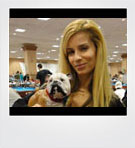 After years of playing this game and many notes taken about what my focus is on when I play my best pool, I have narrowed it down to four absolute essentials for top quality play. In a game where focusing on every detail can lead to brain overload and paralysis by analysis, narrowing down to four basic principles can be a life saver. It took me 15 years to come up with this list, and it's yours to learn in the next 3 minutes.
After years of playing this game and many notes taken about what my focus is on when I play my best pool, I have narrowed it down to four absolute essentials for top quality play. In a game where focusing on every detail can lead to brain overload and paralysis by analysis, narrowing down to four basic principles can be a life saver. It took me 15 years to come up with this list, and it's yours to learn in the next 3 minutes.
1. Make a commitment. As your standing at table you should be evaluating what your next shot will be. Make your choice and commit to it. The shot you choose may not be the right shot in the big picture, but at that moment you have to believe it's the right shot. Shooting the wrong shot with conviction is always better than shooting the right shot with uncertainty, so whatever you choose fire away. If you find yourself second guessing over the ball, get up.
2. Visualize. As you're standing behind the shot you have selected and committed to, create a clear visual of the line of aim and everything that is going to happen on the shot. It is very important to think about exactly what you want to happen and not what you don't want to happen. Thinking about what you don't want to happen puts that visual in your mind, and usually that is the result you get. This is just proof of the power of visualization. Always direct that power to your desired outcome.
3. Focus on your eye patterns. If you've never heard of eye patterns before I wouldn't be surprised. It's not something that is often discussed, but to me it is important enough to make this list. Eye patterns are what your eyes do while you're down on the ball. During my practice strokes as the cue goes forward, I look at where my tip will contact the cueball. As I pull back I focus on where I will contact the object ball. After rocking my eyes back and forth 2 or 3 times, I lock my eyes on the target and...
4. Follow straight through. The only way you'll be able to pinpoint whether it was a aim issue or not is to make sure that cue goes straight through your aim point. When uncertainty creeps in sometimes people steer the cueball by twisting their wrist or throwing out their elbow (the dreaded chicken wing). After all that work you put in, you have to give your shot a chance for success, and the only way to do that is to get that cue moving in the straightest line possible.
I keep these 4 things written down in my phone as a reminder of what I need to focus on when I play. Looking over this list frequently not only keeps my routine in order, but it keeps my thinking focused on the task instead of the outcome. If you're in a slump or playing a match where the heat is on, try to remember these 4 principles, and things should immediately improve.
- Home
- Pooldawg Academy
- Jennifer Barretta
- the four most important things in pool
The Four Most Important Things In Pool
Posted by : Jennifer Barretta